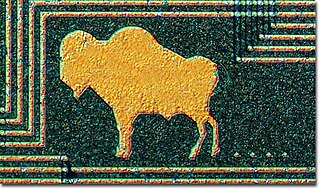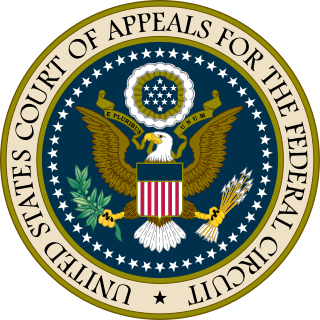A copyright is a type of intellectual property that gives its owner the exclusive right to copy, distribute, adapt, display, and perform a creative work, usually for a limited time. The creative work may be in a literary, artistic, educational, or musical form. Copyright is intended to protect the original expression of an idea in the form of a creative work, but not the idea itself. A copyright is subject to limitations based on public interest considerations, such as the fair use doctrine in the United States.

An integrated circuit or monolithic integrated circuit is a set of electronic circuits on one small flat piece of semiconductor material, usually silicon. Large numbers of tiny MOSFETs integrate into a small chip. This results in circuits that are orders of magnitude smaller, faster, and less expensive than those constructed of discrete electronic components. The IC's mass production capability, reliability, and building-block approach to integrated circuit design has ensured the rapid adoption of standardized ICs in place of designs using discrete transistors. ICs are now used in virtually all electronic equipment and have revolutionized the world of electronics. Computers, mobile phones and other home appliances are now inextricable parts of the structure of modern societies, made possible by the small size and low cost of ICs such as modern computer processors and microcontrollers.
Sui generis is a Latin phrase that means "of its/their own kind", "in a class by itself", therefore "unique".
An industrial design right is an intellectual property right that protects the visual design of objects that are purely utilitarian. An industrial design consists of the creation of a shape, configuration or composition of pattern or color, or combination of pattern and color in three-dimensional form containing aesthetic value. An industrial design can be a two- or three-dimensional pattern used to produce a product, industrial commodity or handicraft.
Software copyright is the application of copyright in law to machine-readable software. While many of the legal principles and policy debates concerning software copyright have close parallels in other domains of copyright law, there are a number of distinctive issues that arise with software. This article primarily focuses on topics particular to software.
A database right is a sui generis property right, comparable to but distinct from copyright, that exists to recognise the investment that is made in compiling a database, even when this does not involve the "creative" aspect that is reflected by copyright. Such rights are often referred to in the plural: database rights.
Intellectual property rights (IPRs) have been acknowledged and protected in China since the 1980s. China has acceded to the major international conventions on protection of rights to intellectual property. Domestically, protection of intellectual property law has also been established by government legislation, administrative regulations, and decrees in the areas of trademark, copyright, and patent. This has led to the creation of a comprehensive legal framework to protect both local and foreign intellectual property. Despite this, copyright violations are extremely common in the PRC. The American Chamber of Commerce in China surveyed over 500 of its members doing business in China regarding IPR for its 2016 China Business Climate Survey Report, and found that IPR enforcement is improving, but significant challenges still remain. The results show that the laws in place exceed their actual enforcement, with patent protection receiving the highest approval rate, while protection of trade secrets lags far behind. Many US companies have claimed that the Chinese government has stolen their intellectual property sometime in 2009–2019.

Chip art, also known as silicon art, chip graffiti or silicon doodling, refers to microscopic artwork built into integrated circuits, also called chips or ICs. Since ICs are printed by photolithography, not constructed a component at a time, there is no additional cost to include features in otherwise unused space on the chip. Designers have used this freedom to put all sorts of artwork on the chips themselves, from designers' simple initials to rather complex drawings. Given the small size of chips, these figures cannot be seen without a microscope. Chip graffiti is sometimes called the hardware version of software easter eggs.

The Copyright, Designs and Patents Act 1988, also known as the CDPA, is an Act of the Parliament of the United Kingdom that received Royal Assent on 15 November 1988. It reformulates almost completely the statutory basis of copyright law in the United Kingdom, which had, until then, been governed by the Copyright Act 1956 (c. 74). It also creates an unregistered design right, and contains a number of modifications to the law of the United Kingdom on Registered Designs and patents.
In copyright law, related rights are the rights of a creative work not connected with the work's actual author. It is used in opposition to the term "authors' rights". Neighbouring rights is a more literal translation of the original French droits voisins. Both authors' rights and related rights are copyrights in the sense of English or U.S. law.
The Design Piracy Prohibition Act, H.R. 2033, S. 1957, and H.R. 2196, were bills of the same name introduced in the United States Congress that would have amended Title 17 of the United States Code to provide sui generis protection to fashion designs for a period of three years. The Acts would have extend protection to "the appearance as a whole of an article of apparel, including its ornamentation," with "apparel" defined to include "men's, women's, or children's clothing, including undergarments, outerwear, gloves, footwear, and headgear;" "handbags, purses, and tote bags;" belts, and eyeglass frames. In order to receive the three-year term of protection, the designer would be required to register with the U.S. Copyright Office within three months of going public with the design.
Feist Publications, Inc., v. Rural Telephone Service Co., 499 U.S. 340 (1991), was a landmark decision by the Supreme Court of the United States establishing that information alone without a minimum of original creativity cannot be protected by copyright. In the case appealed, Feist had copied information from Rural's telephone listings to include in its own, after Rural had refused to license the information. Rural sued for copyright infringement. The Court ruled that information contained in Rural's phone directory was not copyrightable and that therefore no infringement existed.
The WIPO Copyright and Performances and Phonograms Treaties Implementation Act, is a part of the Digital Millennium Copyright Act (DMCA), a 1998 U.S. law. It has two major portions, Section 102, which implements the requirements of the WIPO Copyright Treaty, and Section 103, which arguably provides additional protection against the circumvention of copy prevention systems and prohibits the removal of copyright management information.
Under the law of United Kingdom, a copyright is an intangible property right subsisting in certain qualifying subject-matter. Copyright law is governed by the Copyright, Designs and Patents Act 1988, as amended from time to time. As a result of increasing legal integration and harmonisation throughout the European Union a complete picture of the law can only be acquired through recourse to EU jurisprudence, although this is likely to change by the expiration of the Brexit transition period on 31 December 2020, the UK having left the EU on 31 January 2020. On 12 September 2018 the European Parliament approved new copyright rules to help secure the rights of writers and musicians.
Layout designs (topographies) of integrated circuits are a field in the protection of intellectual property.
Bonito Boats, Inc. v. Thunder Craft Boats, Inc., 489 U.S. 141 (1989), is a decision of the United States Supreme Court holding a state anti-plug molding law preempted because it partially duplicated and therefore interfered with the balance Congress had struck by federal patent law. The decision reaffirmed the Supreme Court's earlier decision in Sears, Roebuck & Co. v. Stiffel Co. (1964), which held a state unfair competition law preempted on the same ground.

Stevens v Kabushiki Kaisha Sony Computer Entertainment, was a decision of the High Court of Australia concerning the "anti-circumvention" provisions of the Copyright Act 1968. The appellant, Stevens, had sold and installed modchips that circumvented the Sony PlayStation's copy protection mechanism. Sony argued that Stevens had knowingly sold or distributed a "circumvention device" which was capable of circumventing a "technological protection measure", contrary to s 116A of the Copyright Act.

Canadian intellectual property law governs the regulation of the exploitation of intellectual property in Canada. Creators of intellectual property gain rights either by statute or by the common law. Intellectual property is governed both by provincial and federal jurisdiction, although most legislation and judicial activity occur at the federal level.

Atari Games Corp. v. Nintendo of America Inc., 975 F.2d 832, is a United States Court of Appeals for the Federal Circuit case, in which the court held that Atari Games engaged in copyright infringement by copying Nintendo's lock-out system, the 10NES. The 10NES was designed to prevent Nintendo's video game console, the Nintendo Entertainment System (NES), from accepting unauthorized game cartridges. Atari, after unsuccessful attempts to reverse engineer the lock-out system, obtained an unauthorized copy of the source code from the Copyright Office and used it to create its 10NES replica, the Rabbit. The case involved copyright infringement claims by Nintendo and a defense based on fair use and copyright misuse by Atari.
The protection of intellectual property (IP) of video games through copyright, patents, and trademarks, shares similar issues with the copyrightability of software as a relatively new area of IP law. The video game industry itself is built on the nature of reusing game concepts from prior games to create new gameplay styles but bounded by illegally direct cloning of existing games, and has made defining intellectual property protections difficult since it is not a fixed medium.






